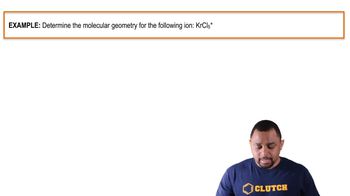The molecule shown here is called furan. It is represented in the typical shorthand way for organic molecules, with hydrogen atoms not shown, and each of the four vertices representing a carbon atom. e. The bond angles in furan are much smaller than those in benzene. The likely reason is which of the following? i. The hybridization of the carbon atoms in furan is different from that in benzene. ii. Furan does not have another resonance structure equivalent to the one shown here. iii. The atoms are forced to adopt smaller angles in a five-membered ring than in a six-membered ring. [Section 9.5]
Ch.9 - Molecular Geometry and Bonding Theories
Chapter 9, Problem 16b
b. The NH3 molecule is trigonal pyramidal, while BF3 is trigonal planar. Which of these molecules is flat?
 Verified step by step guidance
Verified step by step guidance1
Identify the molecular geometry of each molecule: NH3 is trigonal pyramidal, and BF3 is trigonal planar.
Understand the characteristics of each geometry: Trigonal pyramidal has a three-dimensional shape due to the presence of a lone pair on the central atom, while trigonal planar is flat with all atoms in the same plane.
Consider the effect of lone pairs: In NH3, the lone pair on nitrogen pushes the hydrogen atoms down, creating a three-dimensional shape.
Recognize that BF3 has no lone pairs on the central boron atom, allowing all atoms to lie in the same plane.
Conclude that the molecule with a trigonal planar geometry, BF3, is flat, while NH3 is not flat due to its trigonal pyramidal shape.

Verified Solution
Video duration:
2mWas this helpful?
Key Concepts
Here are the essential concepts you must grasp in order to answer the question correctly.
Molecular Geometry
Molecular geometry refers to the three-dimensional arrangement of atoms within a molecule. It is determined by the number of bonding pairs and lone pairs of electrons around the central atom, which influences the shape. For example, NH3 (ammonia) has a trigonal pyramidal shape due to one lone pair, while BF3 (boron trifluoride) has a trigonal planar shape with no lone pairs.
Recommended video:
Guided course

Molecular Geometry with Two Electron Groups
Trigonal Planar Geometry
Trigonal planar geometry occurs when a central atom is bonded to three other atoms, with all bonds lying in the same plane. This arrangement minimizes electron pair repulsion, resulting in bond angles of approximately 120 degrees. BF3 exemplifies this geometry, making it a flat molecule.
Recommended video:
Guided course

Trigonal Planar Example
Trigonal Pyramidal Geometry
Trigonal pyramidal geometry is characterized by a central atom bonded to three other atoms and having one lone pair of electrons. This lone pair pushes down on the bonded atoms, creating a pyramid-like shape with bond angles less than 109.5 degrees. NH3 is an example of this geometry, which results in a non-flat, three-dimensional structure.
Recommended video:
Guided course

Square Pyramidal Example
Related Practice
Textbook Question
Textbook Question
The following is part of a molecular orbital energy-level diagram for MOs constructed from 1s atomic orbitals.
(a) What labels do we use for the two MOs shown?
737
views
Textbook Question
a. Methane (CH4) and the perchlorate ion (ClO4−) are both described as tetrahedral. What does this indicate about their bond angles?
1
views
Textbook Question
Describe the bond angles to be found in each of the following molecular structures: (a) trigonal planar, (b) tetrahedral, (c) octahedral, (d) linear.
1070
views
Textbook Question
(b) An AB4 molecule has two lone pairs of electrons on the A atom (in addition to the four B atoms). What is the electron-domain geometry around the A atom?
1283
views
Textbook Question
Would you expect the nonbonding electron-pair domain in NH3 to be greater or less in size than the corresponding one in PH3?
1
views
